Research Project: Consumer Behaviour in Online vs. Offline Shopping
VerifiedAdded on 2020/12/08
|15
|3991
|395
Report
AI Summary
This research project investigates consumer behavior in the context of online versus offline shopping, aiming to understand consumer preferences and choices. The report begins with an introduction that outlines the background, purpose, aim, objectives, and rationale of the research. The methodology chapter details the research approach (inductive), strategy (qualitative), design (descriptive), data collection methods (primary via questionnaires, secondary via books, journals, and online sources), sampling (random sampling of 20 customers), and data analysis techniques (thematic analysis). The results and findings are presented through thematic analysis, revealing consumer preferences for both online and offline modes, concerns about product accuracy in online shopping, and the importance of trust and reliability in offline shopping. The discussion chapter interprets these findings, followed by a conclusion summarizing the key insights and recommendations for businesses and future research. The report also includes references and an appendix.

Research Project
Paraphrase This Document
Need a fresh take? Get an instant paraphrase of this document with our AI Paraphraser
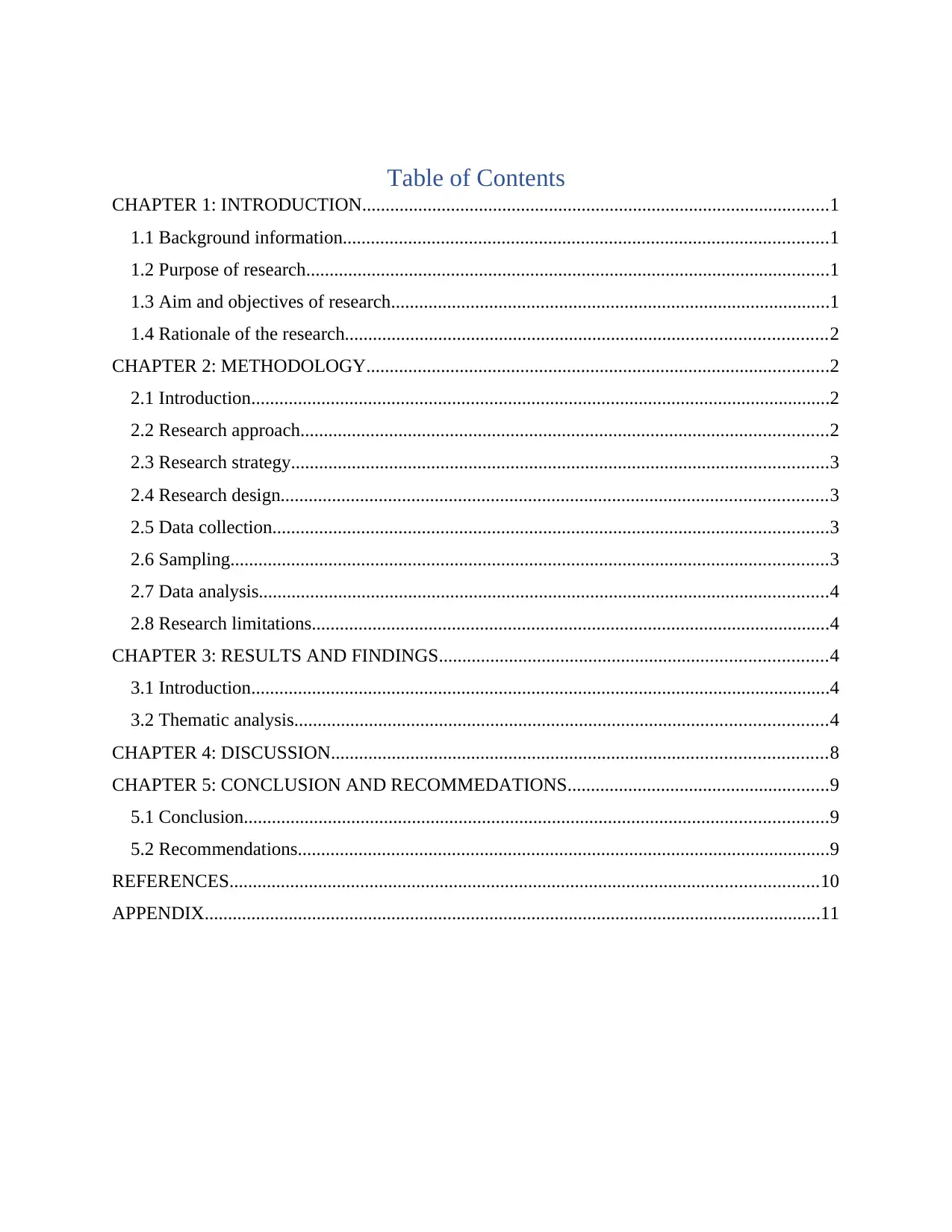
Table of Contents
CHAPTER 1: INTRODUCTION....................................................................................................1
1.1 Background information........................................................................................................1
1.2 Purpose of research................................................................................................................1
1.3 Aim and objectives of research..............................................................................................1
1.4 Rationale of the research.......................................................................................................2
CHAPTER 2: METHODOLOGY...................................................................................................2
2.1 Introduction............................................................................................................................2
2.2 Research approach.................................................................................................................2
2.3 Research strategy...................................................................................................................3
2.4 Research design.....................................................................................................................3
2.5 Data collection.......................................................................................................................3
2.6 Sampling................................................................................................................................3
2.7 Data analysis..........................................................................................................................4
2.8 Research limitations...............................................................................................................4
CHAPTER 3: RESULTS AND FINDINGS...................................................................................4
3.1 Introduction............................................................................................................................4
3.2 Thematic analysis..................................................................................................................4
CHAPTER 4: DISCUSSION..........................................................................................................8
CHAPTER 5: CONCLUSION AND RECOMMEDATIONS........................................................9
5.1 Conclusion.............................................................................................................................9
5.2 Recommendations..................................................................................................................9
REFERENCES..............................................................................................................................10
APPENDIX....................................................................................................................................11
CHAPTER 1: INTRODUCTION....................................................................................................1
1.1 Background information........................................................................................................1
1.2 Purpose of research................................................................................................................1
1.3 Aim and objectives of research..............................................................................................1
1.4 Rationale of the research.......................................................................................................2
CHAPTER 2: METHODOLOGY...................................................................................................2
2.1 Introduction............................................................................................................................2
2.2 Research approach.................................................................................................................2
2.3 Research strategy...................................................................................................................3
2.4 Research design.....................................................................................................................3
2.5 Data collection.......................................................................................................................3
2.6 Sampling................................................................................................................................3
2.7 Data analysis..........................................................................................................................4
2.8 Research limitations...............................................................................................................4
CHAPTER 3: RESULTS AND FINDINGS...................................................................................4
3.1 Introduction............................................................................................................................4
3.2 Thematic analysis..................................................................................................................4
CHAPTER 4: DISCUSSION..........................................................................................................8
CHAPTER 5: CONCLUSION AND RECOMMEDATIONS........................................................9
5.1 Conclusion.............................................................................................................................9
5.2 Recommendations..................................................................................................................9
REFERENCES..............................................................................................................................10
APPENDIX....................................................................................................................................11
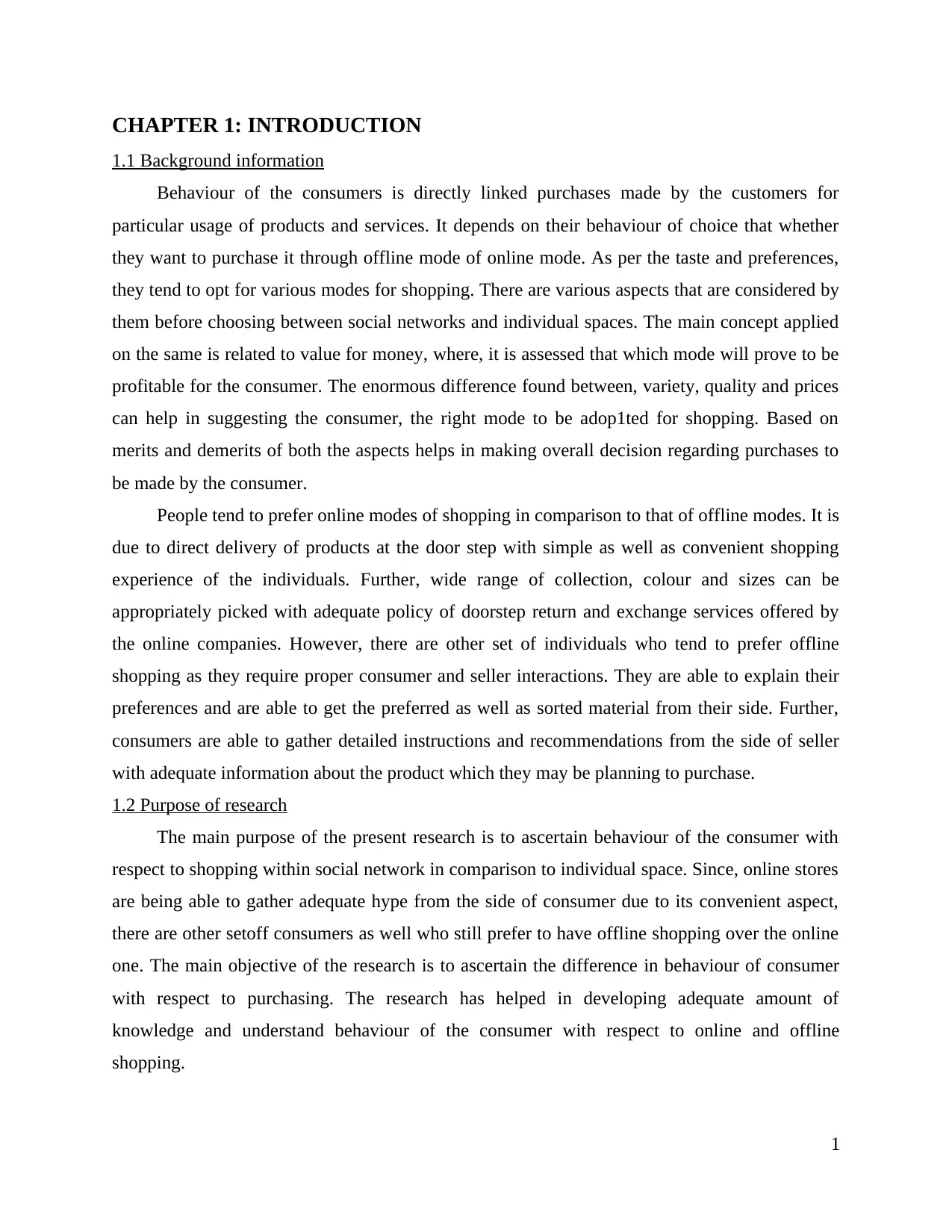
CHAPTER 1: INTRODUCTION
1.1 Background information
Behaviour of the consumers is directly linked purchases made by the customers for
particular usage of products and services. It depends on their behaviour of choice that whether
they want to purchase it through offline mode of online mode. As per the taste and preferences,
they tend to opt for various modes for shopping. There are various aspects that are considered by
them before choosing between social networks and individual spaces. The main concept applied
on the same is related to value for money, where, it is assessed that which mode will prove to be
profitable for the consumer. The enormous difference found between, variety, quality and prices
can help in suggesting the consumer, the right mode to be adop1ted for shopping. Based on
merits and demerits of both the aspects helps in making overall decision regarding purchases to
be made by the consumer.
People tend to prefer online modes of shopping in comparison to that of offline modes. It is
due to direct delivery of products at the door step with simple as well as convenient shopping
experience of the individuals. Further, wide range of collection, colour and sizes can be
appropriately picked with adequate policy of doorstep return and exchange services offered by
the online companies. However, there are other set of individuals who tend to prefer offline
shopping as they require proper consumer and seller interactions. They are able to explain their
preferences and are able to get the preferred as well as sorted material from their side. Further,
consumers are able to gather detailed instructions and recommendations from the side of seller
with adequate information about the product which they may be planning to purchase.
1.2 Purpose of research
The main purpose of the present research is to ascertain behaviour of the consumer with
respect to shopping within social network in comparison to individual space. Since, online stores
are being able to gather adequate hype from the side of consumer due to its convenient aspect,
there are other setoff consumers as well who still prefer to have offline shopping over the online
one. The main objective of the research is to ascertain the difference in behaviour of consumer
with respect to purchasing. The research has helped in developing adequate amount of
knowledge and understand behaviour of the consumer with respect to online and offline
shopping.
1
1.1 Background information
Behaviour of the consumers is directly linked purchases made by the customers for
particular usage of products and services. It depends on their behaviour of choice that whether
they want to purchase it through offline mode of online mode. As per the taste and preferences,
they tend to opt for various modes for shopping. There are various aspects that are considered by
them before choosing between social networks and individual spaces. The main concept applied
on the same is related to value for money, where, it is assessed that which mode will prove to be
profitable for the consumer. The enormous difference found between, variety, quality and prices
can help in suggesting the consumer, the right mode to be adop1ted for shopping. Based on
merits and demerits of both the aspects helps in making overall decision regarding purchases to
be made by the consumer.
People tend to prefer online modes of shopping in comparison to that of offline modes. It is
due to direct delivery of products at the door step with simple as well as convenient shopping
experience of the individuals. Further, wide range of collection, colour and sizes can be
appropriately picked with adequate policy of doorstep return and exchange services offered by
the online companies. However, there are other set of individuals who tend to prefer offline
shopping as they require proper consumer and seller interactions. They are able to explain their
preferences and are able to get the preferred as well as sorted material from their side. Further,
consumers are able to gather detailed instructions and recommendations from the side of seller
with adequate information about the product which they may be planning to purchase.
1.2 Purpose of research
The main purpose of the present research is to ascertain behaviour of the consumer with
respect to shopping within social network in comparison to individual space. Since, online stores
are being able to gather adequate hype from the side of consumer due to its convenient aspect,
there are other setoff consumers as well who still prefer to have offline shopping over the online
one. The main objective of the research is to ascertain the difference in behaviour of consumer
with respect to purchasing. The research has helped in developing adequate amount of
knowledge and understand behaviour of the consumer with respect to online and offline
shopping.
1
⊘ This is a preview!⊘
Do you want full access?
Subscribe today to unlock all pages.

Trusted by 1+ million students worldwide
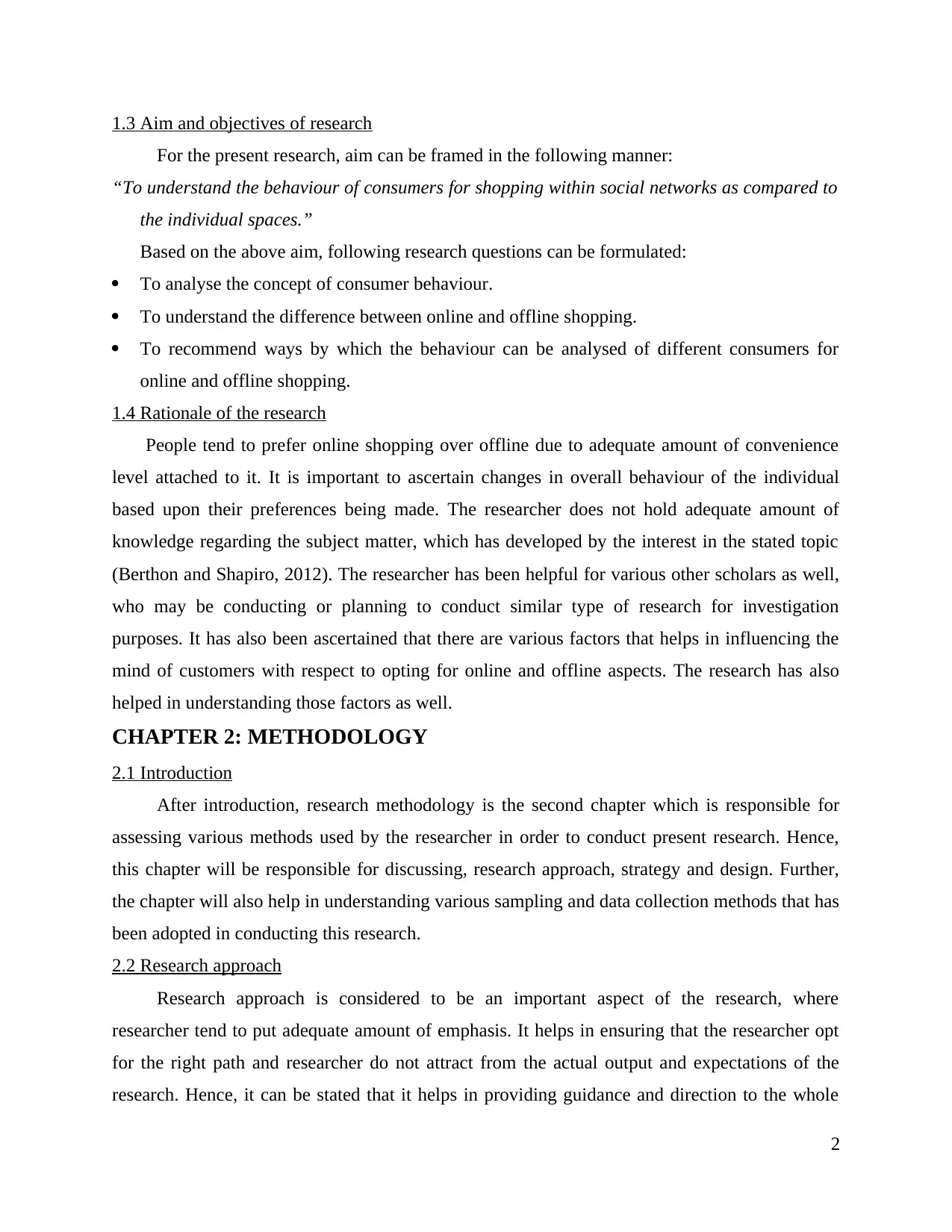
1.3 Aim and objectives of research
For the present research, aim can be framed in the following manner:
“To understand the behaviour of consumers for shopping within social networks as compared to
the individual spaces.”
Based on the above aim, following research questions can be formulated:
To analyse the concept of consumer behaviour.
To understand the difference between online and offline shopping.
To recommend ways by which the behaviour can be analysed of different consumers for
online and offline shopping.
1.4 Rationale of the research
People tend to prefer online shopping over offline due to adequate amount of convenience
level attached to it. It is important to ascertain changes in overall behaviour of the individual
based upon their preferences being made. The researcher does not hold adequate amount of
knowledge regarding the subject matter, which has developed by the interest in the stated topic
(Berthon and Shapiro, 2012). The researcher has been helpful for various other scholars as well,
who may be conducting or planning to conduct similar type of research for investigation
purposes. It has also been ascertained that there are various factors that helps in influencing the
mind of customers with respect to opting for online and offline aspects. The research has also
helped in understanding those factors as well.
CHAPTER 2: METHODOLOGY
2.1 Introduction
After introduction, research methodology is the second chapter which is responsible for
assessing various methods used by the researcher in order to conduct present research. Hence,
this chapter will be responsible for discussing, research approach, strategy and design. Further,
the chapter will also help in understanding various sampling and data collection methods that has
been adopted in conducting this research.
2.2 Research approach
Research approach is considered to be an important aspect of the research, where
researcher tend to put adequate amount of emphasis. It helps in ensuring that the researcher opt
for the right path and researcher do not attract from the actual output and expectations of the
research. Hence, it can be stated that it helps in providing guidance and direction to the whole
2
For the present research, aim can be framed in the following manner:
“To understand the behaviour of consumers for shopping within social networks as compared to
the individual spaces.”
Based on the above aim, following research questions can be formulated:
To analyse the concept of consumer behaviour.
To understand the difference between online and offline shopping.
To recommend ways by which the behaviour can be analysed of different consumers for
online and offline shopping.
1.4 Rationale of the research
People tend to prefer online shopping over offline due to adequate amount of convenience
level attached to it. It is important to ascertain changes in overall behaviour of the individual
based upon their preferences being made. The researcher does not hold adequate amount of
knowledge regarding the subject matter, which has developed by the interest in the stated topic
(Berthon and Shapiro, 2012). The researcher has been helpful for various other scholars as well,
who may be conducting or planning to conduct similar type of research for investigation
purposes. It has also been ascertained that there are various factors that helps in influencing the
mind of customers with respect to opting for online and offline aspects. The research has also
helped in understanding those factors as well.
CHAPTER 2: METHODOLOGY
2.1 Introduction
After introduction, research methodology is the second chapter which is responsible for
assessing various methods used by the researcher in order to conduct present research. Hence,
this chapter will be responsible for discussing, research approach, strategy and design. Further,
the chapter will also help in understanding various sampling and data collection methods that has
been adopted in conducting this research.
2.2 Research approach
Research approach is considered to be an important aspect of the research, where
researcher tend to put adequate amount of emphasis. It helps in ensuring that the researcher opt
for the right path and researcher do not attract from the actual output and expectations of the
research. Hence, it can be stated that it helps in providing guidance and direction to the whole
2
Paraphrase This Document
Need a fresh take? Get an instant paraphrase of this document with our AI Paraphraser
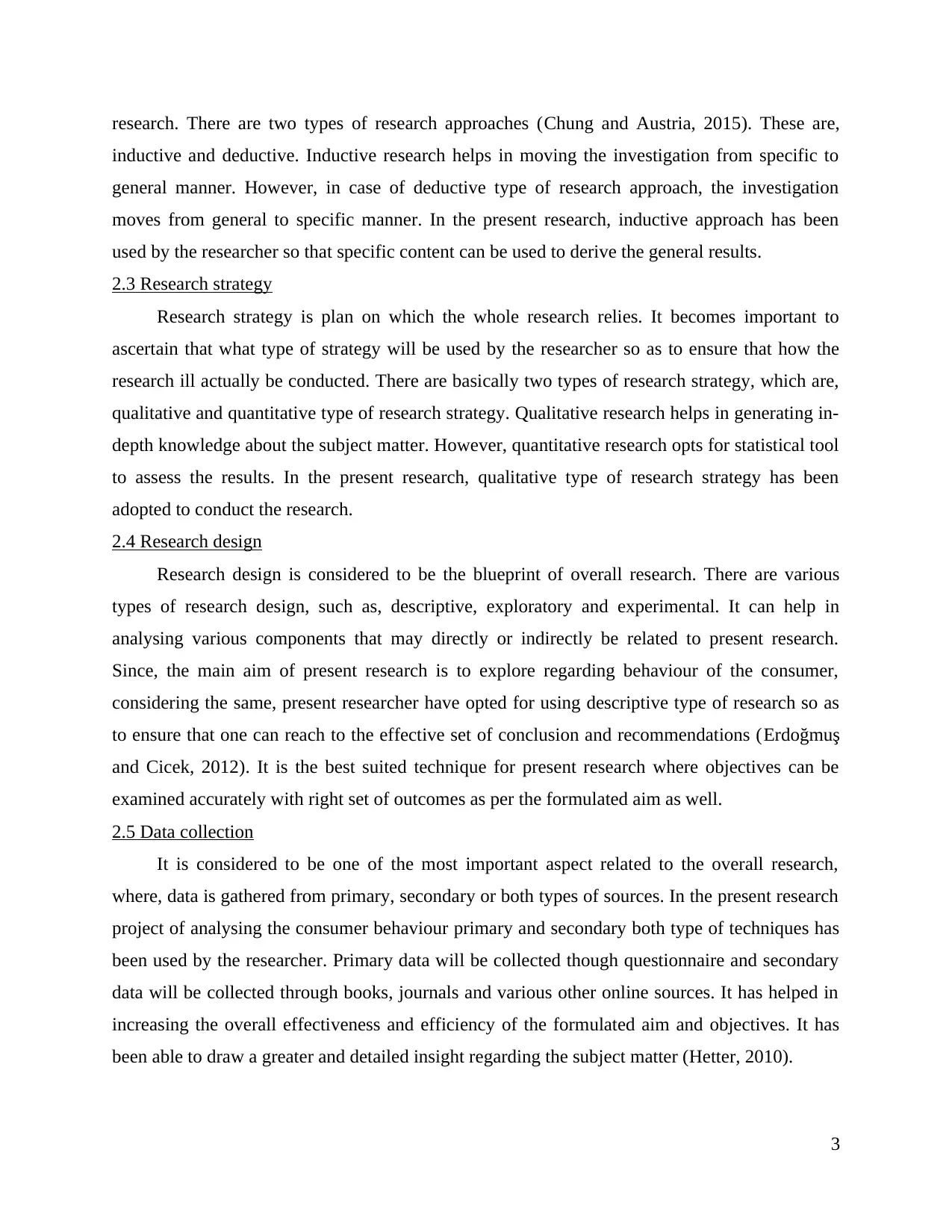
research. There are two types of research approaches (Chung and Austria, 2015). These are,
inductive and deductive. Inductive research helps in moving the investigation from specific to
general manner. However, in case of deductive type of research approach, the investigation
moves from general to specific manner. In the present research, inductive approach has been
used by the researcher so that specific content can be used to derive the general results.
2.3 Research strategy
Research strategy is plan on which the whole research relies. It becomes important to
ascertain that what type of strategy will be used by the researcher so as to ensure that how the
research ill actually be conducted. There are basically two types of research strategy, which are,
qualitative and quantitative type of research strategy. Qualitative research helps in generating in-
depth knowledge about the subject matter. However, quantitative research opts for statistical tool
to assess the results. In the present research, qualitative type of research strategy has been
adopted to conduct the research.
2.4 Research design
Research design is considered to be the blueprint of overall research. There are various
types of research design, such as, descriptive, exploratory and experimental. It can help in
analysing various components that may directly or indirectly be related to present research.
Since, the main aim of present research is to explore regarding behaviour of the consumer,
considering the same, present researcher have opted for using descriptive type of research so as
to ensure that one can reach to the effective set of conclusion and recommendations (Erdoğmuş
and Cicek, 2012). It is the best suited technique for present research where objectives can be
examined accurately with right set of outcomes as per the formulated aim as well.
2.5 Data collection
It is considered to be one of the most important aspect related to the overall research,
where, data is gathered from primary, secondary or both types of sources. In the present research
project of analysing the consumer behaviour primary and secondary both type of techniques has
been used by the researcher. Primary data will be collected though questionnaire and secondary
data will be collected through books, journals and various other online sources. It has helped in
increasing the overall effectiveness and efficiency of the formulated aim and objectives. It has
been able to draw a greater and detailed insight regarding the subject matter (Hetter, 2010).
3
inductive and deductive. Inductive research helps in moving the investigation from specific to
general manner. However, in case of deductive type of research approach, the investigation
moves from general to specific manner. In the present research, inductive approach has been
used by the researcher so that specific content can be used to derive the general results.
2.3 Research strategy
Research strategy is plan on which the whole research relies. It becomes important to
ascertain that what type of strategy will be used by the researcher so as to ensure that how the
research ill actually be conducted. There are basically two types of research strategy, which are,
qualitative and quantitative type of research strategy. Qualitative research helps in generating in-
depth knowledge about the subject matter. However, quantitative research opts for statistical tool
to assess the results. In the present research, qualitative type of research strategy has been
adopted to conduct the research.
2.4 Research design
Research design is considered to be the blueprint of overall research. There are various
types of research design, such as, descriptive, exploratory and experimental. It can help in
analysing various components that may directly or indirectly be related to present research.
Since, the main aim of present research is to explore regarding behaviour of the consumer,
considering the same, present researcher have opted for using descriptive type of research so as
to ensure that one can reach to the effective set of conclusion and recommendations (Erdoğmuş
and Cicek, 2012). It is the best suited technique for present research where objectives can be
examined accurately with right set of outcomes as per the formulated aim as well.
2.5 Data collection
It is considered to be one of the most important aspect related to the overall research,
where, data is gathered from primary, secondary or both types of sources. In the present research
project of analysing the consumer behaviour primary and secondary both type of techniques has
been used by the researcher. Primary data will be collected though questionnaire and secondary
data will be collected through books, journals and various other online sources. It has helped in
increasing the overall effectiveness and efficiency of the formulated aim and objectives. It has
been able to draw a greater and detailed insight regarding the subject matter (Hetter, 2010).
3
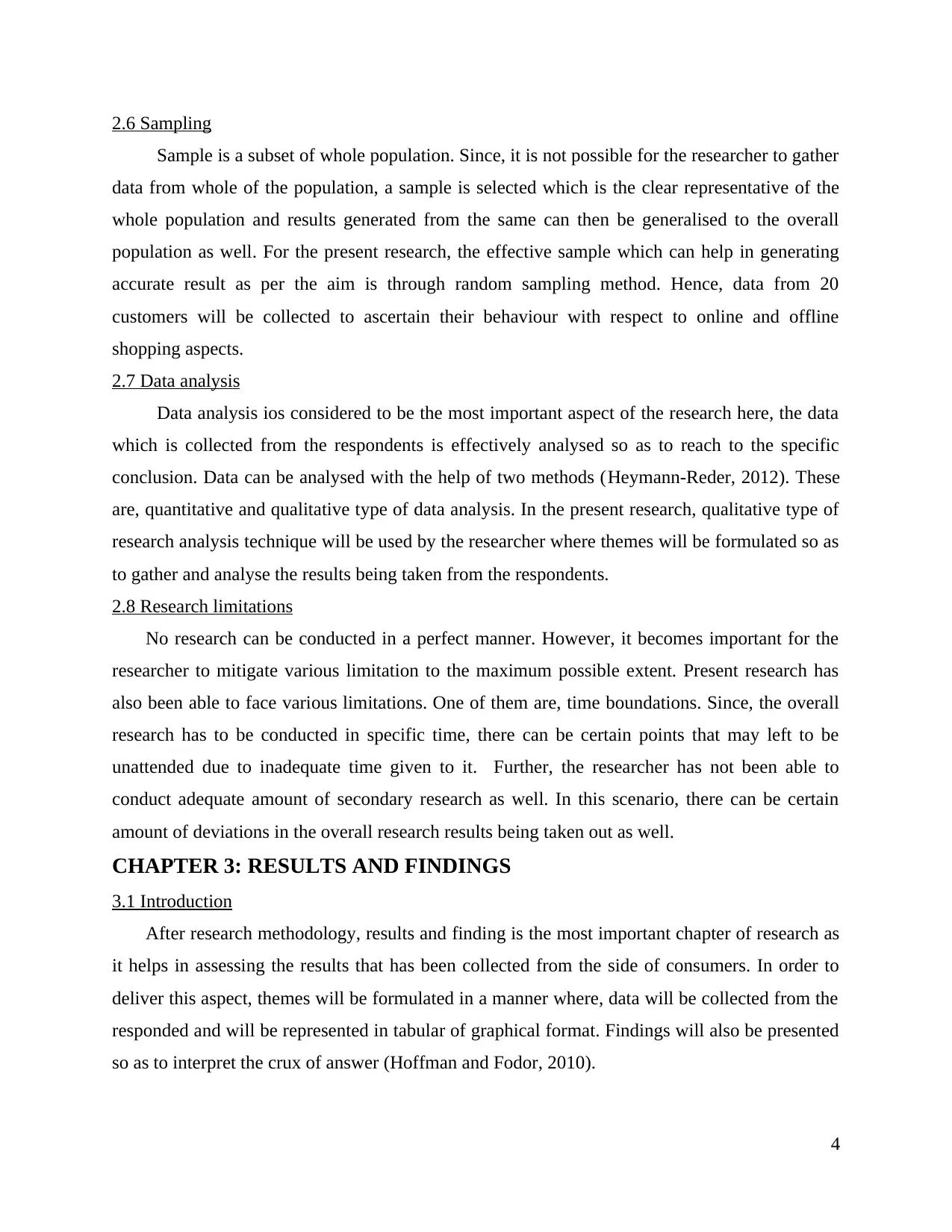
2.6 Sampling
Sample is a subset of whole population. Since, it is not possible for the researcher to gather
data from whole of the population, a sample is selected which is the clear representative of the
whole population and results generated from the same can then be generalised to the overall
population as well. For the present research, the effective sample which can help in generating
accurate result as per the aim is through random sampling method. Hence, data from 20
customers will be collected to ascertain their behaviour with respect to online and offline
shopping aspects.
2.7 Data analysis
Data analysis ios considered to be the most important aspect of the research here, the data
which is collected from the respondents is effectively analysed so as to reach to the specific
conclusion. Data can be analysed with the help of two methods (Heymann-Reder, 2012). These
are, quantitative and qualitative type of data analysis. In the present research, qualitative type of
research analysis technique will be used by the researcher where themes will be formulated so as
to gather and analyse the results being taken from the respondents.
2.8 Research limitations
No research can be conducted in a perfect manner. However, it becomes important for the
researcher to mitigate various limitation to the maximum possible extent. Present research has
also been able to face various limitations. One of them are, time boundations. Since, the overall
research has to be conducted in specific time, there can be certain points that may left to be
unattended due to inadequate time given to it. Further, the researcher has not been able to
conduct adequate amount of secondary research as well. In this scenario, there can be certain
amount of deviations in the overall research results being taken out as well.
CHAPTER 3: RESULTS AND FINDINGS
3.1 Introduction
After research methodology, results and finding is the most important chapter of research as
it helps in assessing the results that has been collected from the side of consumers. In order to
deliver this aspect, themes will be formulated in a manner where, data will be collected from the
responded and will be represented in tabular of graphical format. Findings will also be presented
so as to interpret the crux of answer (Hoffman and Fodor, 2010).
4
Sample is a subset of whole population. Since, it is not possible for the researcher to gather
data from whole of the population, a sample is selected which is the clear representative of the
whole population and results generated from the same can then be generalised to the overall
population as well. For the present research, the effective sample which can help in generating
accurate result as per the aim is through random sampling method. Hence, data from 20
customers will be collected to ascertain their behaviour with respect to online and offline
shopping aspects.
2.7 Data analysis
Data analysis ios considered to be the most important aspect of the research here, the data
which is collected from the respondents is effectively analysed so as to reach to the specific
conclusion. Data can be analysed with the help of two methods (Heymann-Reder, 2012). These
are, quantitative and qualitative type of data analysis. In the present research, qualitative type of
research analysis technique will be used by the researcher where themes will be formulated so as
to gather and analyse the results being taken from the respondents.
2.8 Research limitations
No research can be conducted in a perfect manner. However, it becomes important for the
researcher to mitigate various limitation to the maximum possible extent. Present research has
also been able to face various limitations. One of them are, time boundations. Since, the overall
research has to be conducted in specific time, there can be certain points that may left to be
unattended due to inadequate time given to it. Further, the researcher has not been able to
conduct adequate amount of secondary research as well. In this scenario, there can be certain
amount of deviations in the overall research results being taken out as well.
CHAPTER 3: RESULTS AND FINDINGS
3.1 Introduction
After research methodology, results and finding is the most important chapter of research as
it helps in assessing the results that has been collected from the side of consumers. In order to
deliver this aspect, themes will be formulated in a manner where, data will be collected from the
responded and will be represented in tabular of graphical format. Findings will also be presented
so as to interpret the crux of answer (Hoffman and Fodor, 2010).
4
⊘ This is a preview!⊘
Do you want full access?
Subscribe today to unlock all pages.

Trusted by 1+ million students worldwide
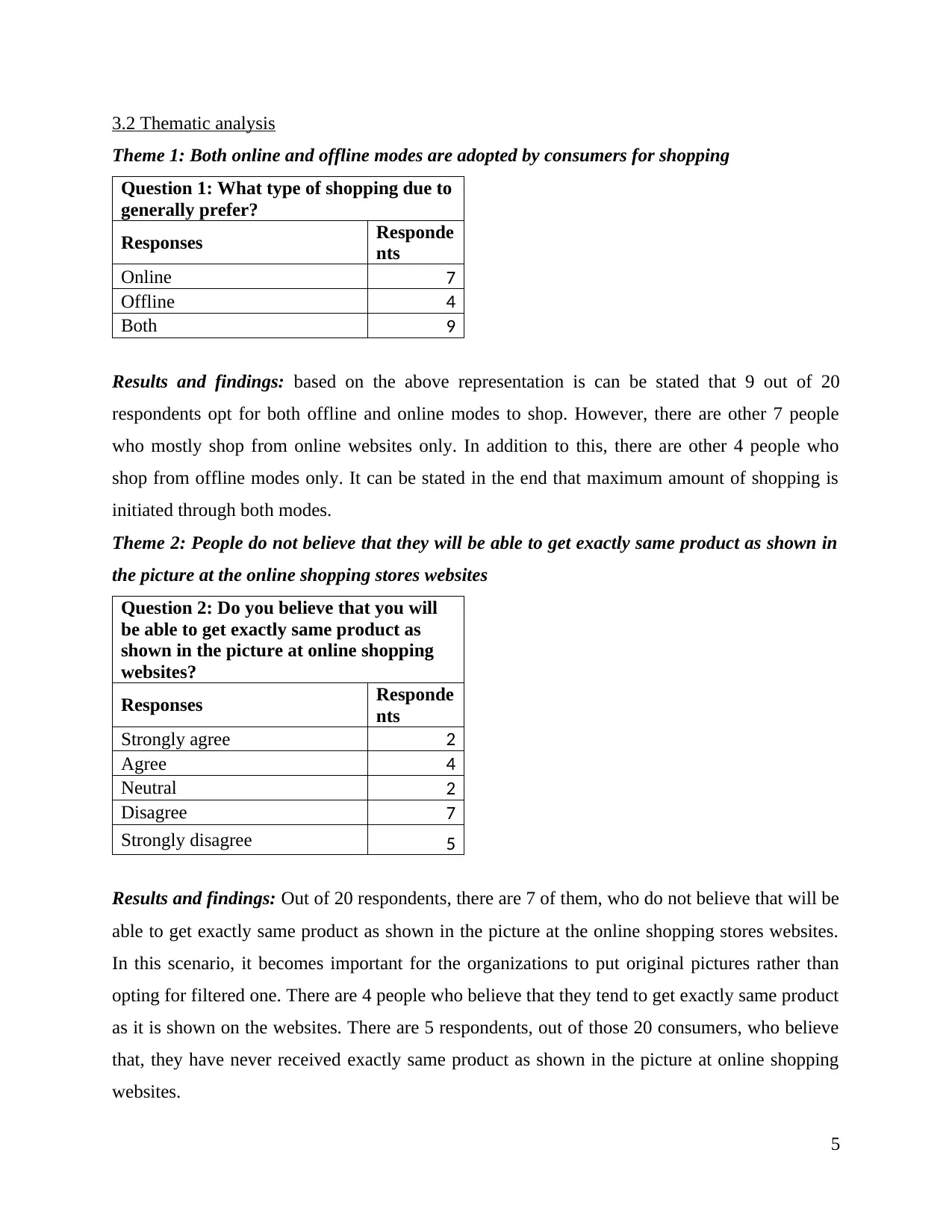
3.2 Thematic analysis
Theme 1: Both online and offline modes are adopted by consumers for shopping
Question 1: What type of shopping due to
generally prefer?
Responses Responde
nts
Online 7
Offline 4
Both 9
Results and findings: based on the above representation is can be stated that 9 out of 20
respondents opt for both offline and online modes to shop. However, there are other 7 people
who mostly shop from online websites only. In addition to this, there are other 4 people who
shop from offline modes only. It can be stated in the end that maximum amount of shopping is
initiated through both modes.
Theme 2: People do not believe that they will be able to get exactly same product as shown in
the picture at the online shopping stores websites
Question 2: Do you believe that you will
be able to get exactly same product as
shown in the picture at online shopping
websites?
Responses Responde
nts
Strongly agree 2
Agree 4
Neutral 2
Disagree 7
Strongly disagree 5
Results and findings: Out of 20 respondents, there are 7 of them, who do not believe that will be
able to get exactly same product as shown in the picture at the online shopping stores websites.
In this scenario, it becomes important for the organizations to put original pictures rather than
opting for filtered one. There are 4 people who believe that they tend to get exactly same product
as it is shown on the websites. There are 5 respondents, out of those 20 consumers, who believe
that, they have never received exactly same product as shown in the picture at online shopping
websites.
5
Theme 1: Both online and offline modes are adopted by consumers for shopping
Question 1: What type of shopping due to
generally prefer?
Responses Responde
nts
Online 7
Offline 4
Both 9
Results and findings: based on the above representation is can be stated that 9 out of 20
respondents opt for both offline and online modes to shop. However, there are other 7 people
who mostly shop from online websites only. In addition to this, there are other 4 people who
shop from offline modes only. It can be stated in the end that maximum amount of shopping is
initiated through both modes.
Theme 2: People do not believe that they will be able to get exactly same product as shown in
the picture at the online shopping stores websites
Question 2: Do you believe that you will
be able to get exactly same product as
shown in the picture at online shopping
websites?
Responses Responde
nts
Strongly agree 2
Agree 4
Neutral 2
Disagree 7
Strongly disagree 5
Results and findings: Out of 20 respondents, there are 7 of them, who do not believe that will be
able to get exactly same product as shown in the picture at the online shopping stores websites.
In this scenario, it becomes important for the organizations to put original pictures rather than
opting for filtered one. There are 4 people who believe that they tend to get exactly same product
as it is shown on the websites. There are 5 respondents, out of those 20 consumers, who believe
that, they have never received exactly same product as shown in the picture at online shopping
websites.
5
Paraphrase This Document
Need a fresh take? Get an instant paraphrase of this document with our AI Paraphraser
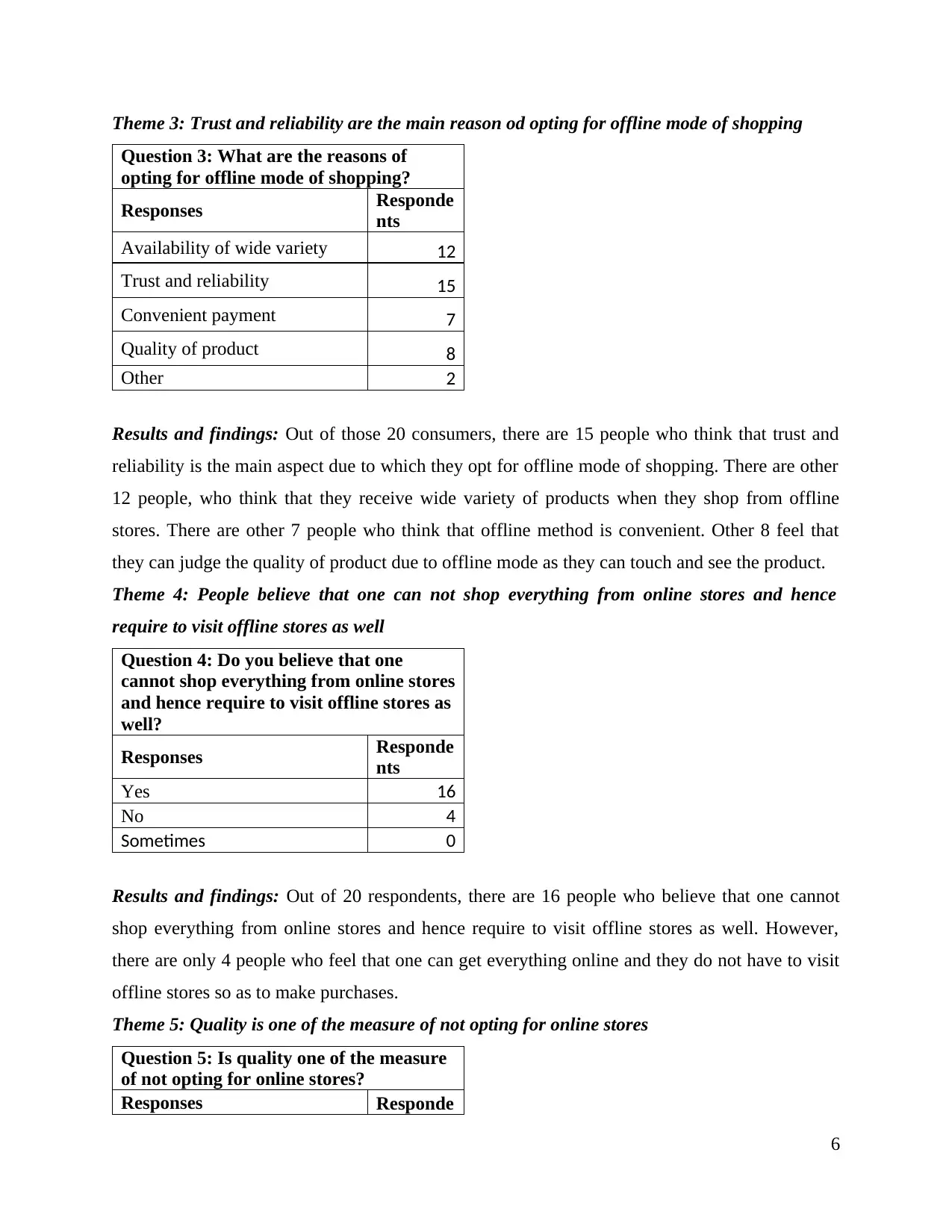
Theme 3: Trust and reliability are the main reason od opting for offline mode of shopping
Question 3: What are the reasons of
opting for offline mode of shopping?
Responses Responde
nts
Availability of wide variety 12
Trust and reliability 15
Convenient payment 7
Quality of product 8
Other 2
Results and findings: Out of those 20 consumers, there are 15 people who think that trust and
reliability is the main aspect due to which they opt for offline mode of shopping. There are other
12 people, who think that they receive wide variety of products when they shop from offline
stores. There are other 7 people who think that offline method is convenient. Other 8 feel that
they can judge the quality of product due to offline mode as they can touch and see the product.
Theme 4: People believe that one can not shop everything from online stores and hence
require to visit offline stores as well
Question 4: Do you believe that one
cannot shop everything from online stores
and hence require to visit offline stores as
well?
Responses Responde
nts
Yes 16
No 4
Sometimes 0
Results and findings: Out of 20 respondents, there are 16 people who believe that one cannot
shop everything from online stores and hence require to visit offline stores as well. However,
there are only 4 people who feel that one can get everything online and they do not have to visit
offline stores so as to make purchases.
Theme 5: Quality is one of the measure of not opting for online stores
Question 5: Is quality one of the measure
of not opting for online stores?
Responses Responde
6
Question 3: What are the reasons of
opting for offline mode of shopping?
Responses Responde
nts
Availability of wide variety 12
Trust and reliability 15
Convenient payment 7
Quality of product 8
Other 2
Results and findings: Out of those 20 consumers, there are 15 people who think that trust and
reliability is the main aspect due to which they opt for offline mode of shopping. There are other
12 people, who think that they receive wide variety of products when they shop from offline
stores. There are other 7 people who think that offline method is convenient. Other 8 feel that
they can judge the quality of product due to offline mode as they can touch and see the product.
Theme 4: People believe that one can not shop everything from online stores and hence
require to visit offline stores as well
Question 4: Do you believe that one
cannot shop everything from online stores
and hence require to visit offline stores as
well?
Responses Responde
nts
Yes 16
No 4
Sometimes 0
Results and findings: Out of 20 respondents, there are 16 people who believe that one cannot
shop everything from online stores and hence require to visit offline stores as well. However,
there are only 4 people who feel that one can get everything online and they do not have to visit
offline stores so as to make purchases.
Theme 5: Quality is one of the measure of not opting for online stores
Question 5: Is quality one of the measure
of not opting for online stores?
Responses Responde
6
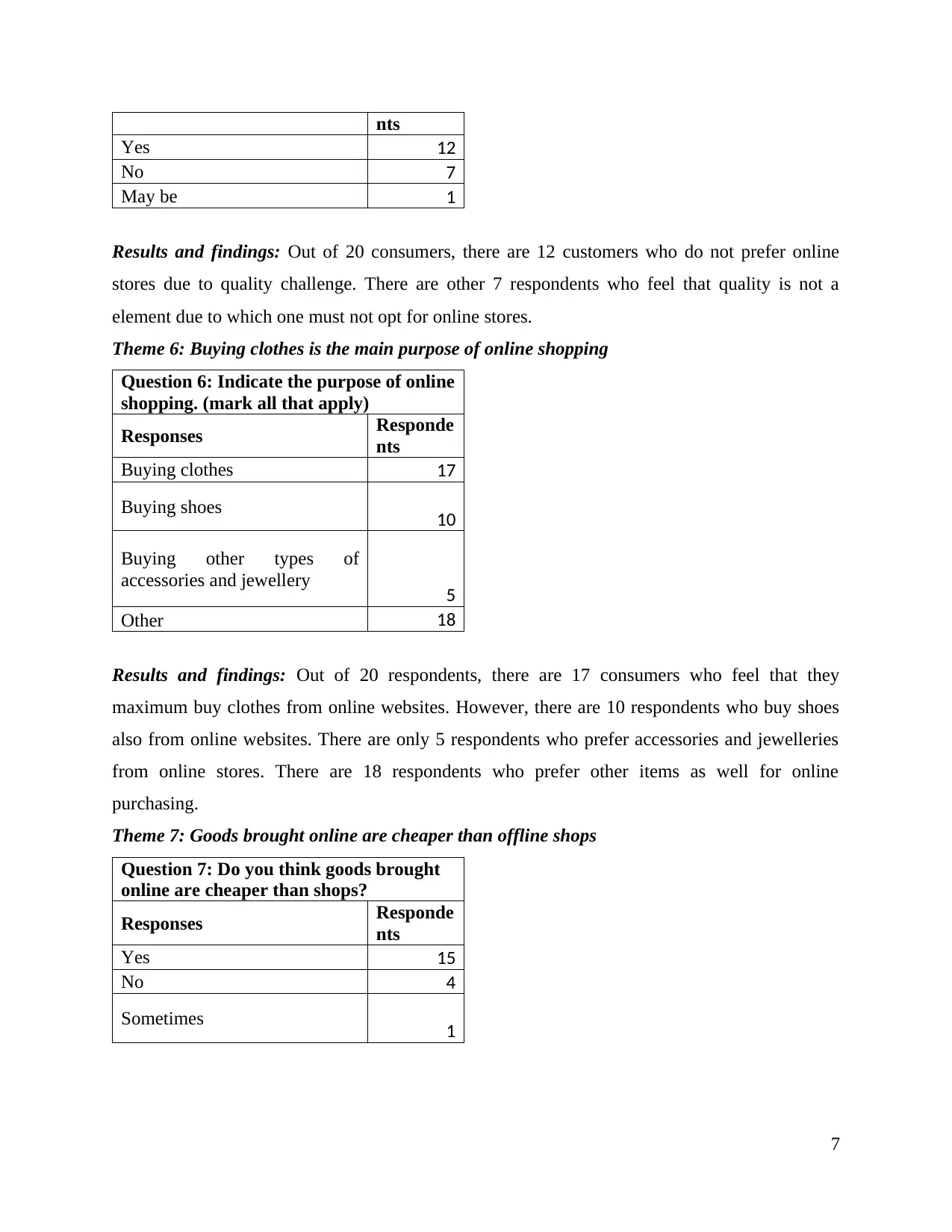
nts
Yes 12
No 7
May be 1
Results and findings: Out of 20 consumers, there are 12 customers who do not prefer online
stores due to quality challenge. There are other 7 respondents who feel that quality is not a
element due to which one must not opt for online stores.
Theme 6: Buying clothes is the main purpose of online shopping
Question 6: Indicate the purpose of online
shopping. (mark all that apply)
Responses Responde
nts
Buying clothes 17
Buying shoes 10
Buying other types of
accessories and jewellery 5
Other 18
Results and findings: Out of 20 respondents, there are 17 consumers who feel that they
maximum buy clothes from online websites. However, there are 10 respondents who buy shoes
also from online websites. There are only 5 respondents who prefer accessories and jewelleries
from online stores. There are 18 respondents who prefer other items as well for online
purchasing.
Theme 7: Goods brought online are cheaper than offline shops
Question 7: Do you think goods brought
online are cheaper than shops?
Responses Responde
nts
Yes 15
No 4
Sometimes 1
7
Yes 12
No 7
May be 1
Results and findings: Out of 20 consumers, there are 12 customers who do not prefer online
stores due to quality challenge. There are other 7 respondents who feel that quality is not a
element due to which one must not opt for online stores.
Theme 6: Buying clothes is the main purpose of online shopping
Question 6: Indicate the purpose of online
shopping. (mark all that apply)
Responses Responde
nts
Buying clothes 17
Buying shoes 10
Buying other types of
accessories and jewellery 5
Other 18
Results and findings: Out of 20 respondents, there are 17 consumers who feel that they
maximum buy clothes from online websites. However, there are 10 respondents who buy shoes
also from online websites. There are only 5 respondents who prefer accessories and jewelleries
from online stores. There are 18 respondents who prefer other items as well for online
purchasing.
Theme 7: Goods brought online are cheaper than offline shops
Question 7: Do you think goods brought
online are cheaper than shops?
Responses Responde
nts
Yes 15
No 4
Sometimes 1
7
⊘ This is a preview!⊘
Do you want full access?
Subscribe today to unlock all pages.

Trusted by 1+ million students worldwide
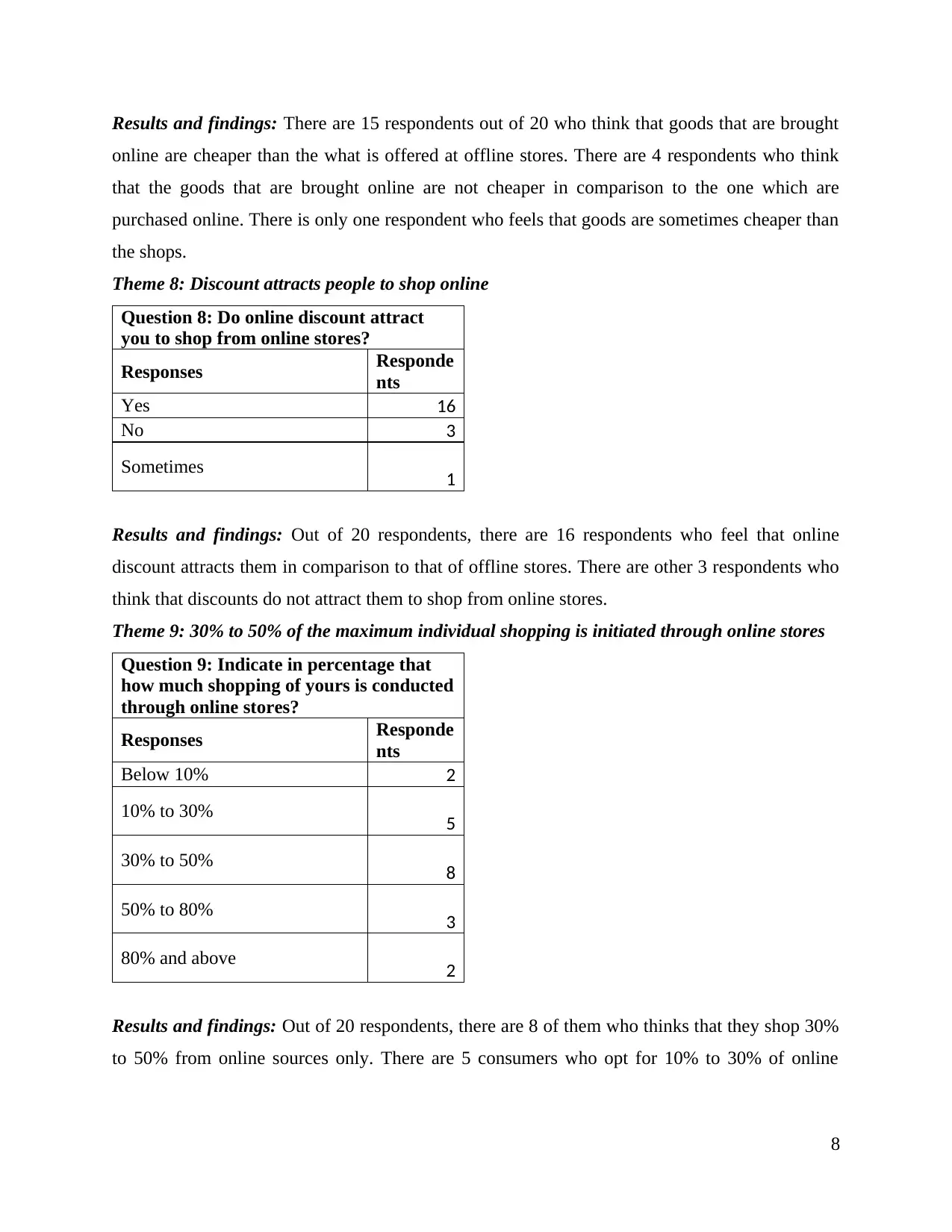
Results and findings: There are 15 respondents out of 20 who think that goods that are brought
online are cheaper than the what is offered at offline stores. There are 4 respondents who think
that the goods that are brought online are not cheaper in comparison to the one which are
purchased online. There is only one respondent who feels that goods are sometimes cheaper than
the shops.
Theme 8: Discount attracts people to shop online
Question 8: Do online discount attract
you to shop from online stores?
Responses Responde
nts
Yes 16
No 3
Sometimes 1
Results and findings: Out of 20 respondents, there are 16 respondents who feel that online
discount attracts them in comparison to that of offline stores. There are other 3 respondents who
think that discounts do not attract them to shop from online stores.
Theme 9: 30% to 50% of the maximum individual shopping is initiated through online stores
Question 9: Indicate in percentage that
how much shopping of yours is conducted
through online stores?
Responses Responde
nts
Below 10% 2
10% to 30% 5
30% to 50% 8
50% to 80% 3
80% and above 2
Results and findings: Out of 20 respondents, there are 8 of them who thinks that they shop 30%
to 50% from online sources only. There are 5 consumers who opt for 10% to 30% of online
8
online are cheaper than the what is offered at offline stores. There are 4 respondents who think
that the goods that are brought online are not cheaper in comparison to the one which are
purchased online. There is only one respondent who feels that goods are sometimes cheaper than
the shops.
Theme 8: Discount attracts people to shop online
Question 8: Do online discount attract
you to shop from online stores?
Responses Responde
nts
Yes 16
No 3
Sometimes 1
Results and findings: Out of 20 respondents, there are 16 respondents who feel that online
discount attracts them in comparison to that of offline stores. There are other 3 respondents who
think that discounts do not attract them to shop from online stores.
Theme 9: 30% to 50% of the maximum individual shopping is initiated through online stores
Question 9: Indicate in percentage that
how much shopping of yours is conducted
through online stores?
Responses Responde
nts
Below 10% 2
10% to 30% 5
30% to 50% 8
50% to 80% 3
80% and above 2
Results and findings: Out of 20 respondents, there are 8 of them who thinks that they shop 30%
to 50% from online sources only. There are 5 consumers who opt for 10% to 30% of online
8
Paraphrase This Document
Need a fresh take? Get an instant paraphrase of this document with our AI Paraphraser
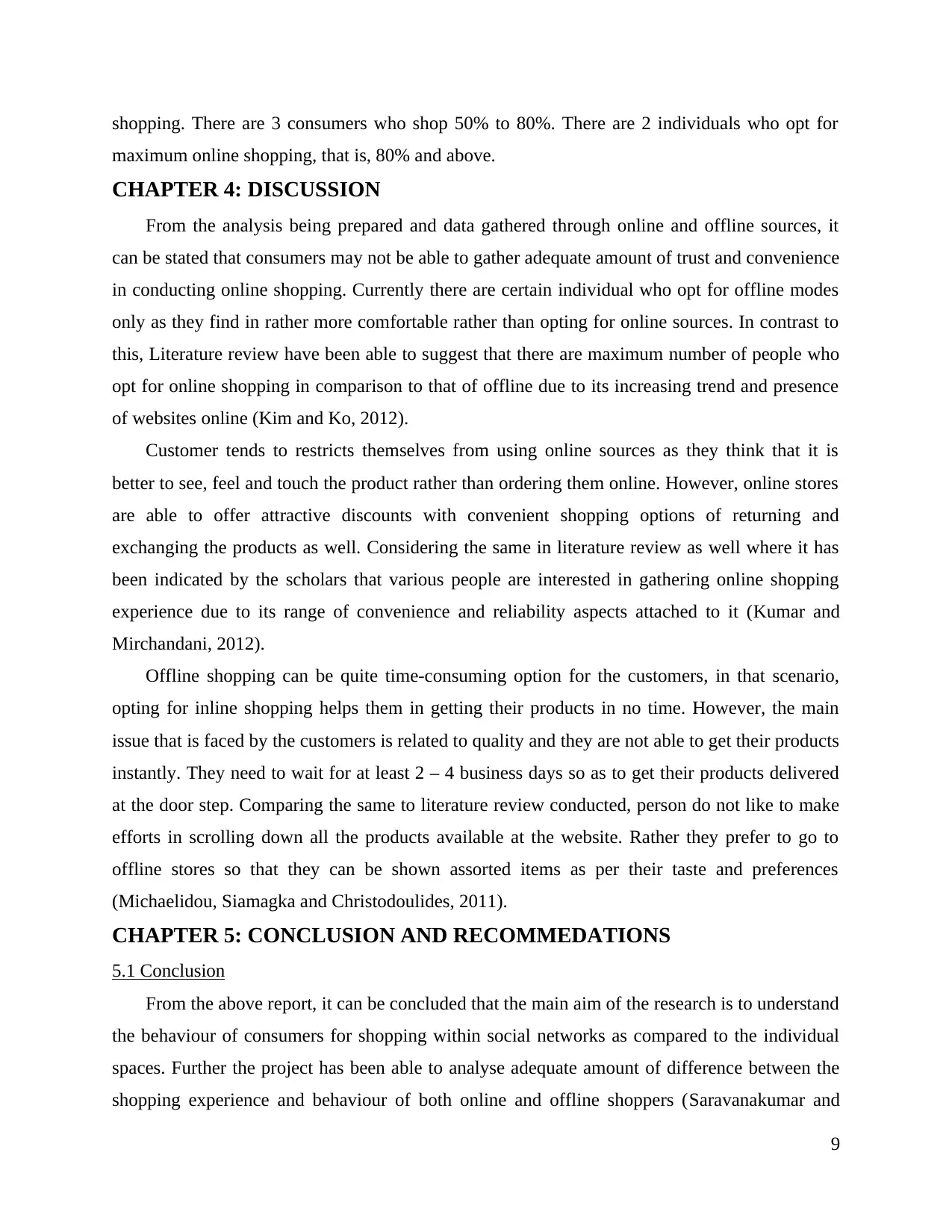
shopping. There are 3 consumers who shop 50% to 80%. There are 2 individuals who opt for
maximum online shopping, that is, 80% and above.
CHAPTER 4: DISCUSSION
From the analysis being prepared and data gathered through online and offline sources, it
can be stated that consumers may not be able to gather adequate amount of trust and convenience
in conducting online shopping. Currently there are certain individual who opt for offline modes
only as they find in rather more comfortable rather than opting for online sources. In contrast to
this, Literature review have been able to suggest that there are maximum number of people who
opt for online shopping in comparison to that of offline due to its increasing trend and presence
of websites online (Kim and Ko, 2012).
Customer tends to restricts themselves from using online sources as they think that it is
better to see, feel and touch the product rather than ordering them online. However, online stores
are able to offer attractive discounts with convenient shopping options of returning and
exchanging the products as well. Considering the same in literature review as well where it has
been indicated by the scholars that various people are interested in gathering online shopping
experience due to its range of convenience and reliability aspects attached to it (Kumar and
Mirchandani, 2012).
Offline shopping can be quite time-consuming option for the customers, in that scenario,
opting for inline shopping helps them in getting their products in no time. However, the main
issue that is faced by the customers is related to quality and they are not able to get their products
instantly. They need to wait for at least 2 – 4 business days so as to get their products delivered
at the door step. Comparing the same to literature review conducted, person do not like to make
efforts in scrolling down all the products available at the website. Rather they prefer to go to
offline stores so that they can be shown assorted items as per their taste and preferences
(Michaelidou, Siamagka and Christodoulides, 2011).
CHAPTER 5: CONCLUSION AND RECOMMEDATIONS
5.1 Conclusion
From the above report, it can be concluded that the main aim of the research is to understand
the behaviour of consumers for shopping within social networks as compared to the individual
spaces. Further the project has been able to analyse adequate amount of difference between the
shopping experience and behaviour of both online and offline shoppers (Saravanakumar and
9
maximum online shopping, that is, 80% and above.
CHAPTER 4: DISCUSSION
From the analysis being prepared and data gathered through online and offline sources, it
can be stated that consumers may not be able to gather adequate amount of trust and convenience
in conducting online shopping. Currently there are certain individual who opt for offline modes
only as they find in rather more comfortable rather than opting for online sources. In contrast to
this, Literature review have been able to suggest that there are maximum number of people who
opt for online shopping in comparison to that of offline due to its increasing trend and presence
of websites online (Kim and Ko, 2012).
Customer tends to restricts themselves from using online sources as they think that it is
better to see, feel and touch the product rather than ordering them online. However, online stores
are able to offer attractive discounts with convenient shopping options of returning and
exchanging the products as well. Considering the same in literature review as well where it has
been indicated by the scholars that various people are interested in gathering online shopping
experience due to its range of convenience and reliability aspects attached to it (Kumar and
Mirchandani, 2012).
Offline shopping can be quite time-consuming option for the customers, in that scenario,
opting for inline shopping helps them in getting their products in no time. However, the main
issue that is faced by the customers is related to quality and they are not able to get their products
instantly. They need to wait for at least 2 – 4 business days so as to get their products delivered
at the door step. Comparing the same to literature review conducted, person do not like to make
efforts in scrolling down all the products available at the website. Rather they prefer to go to
offline stores so that they can be shown assorted items as per their taste and preferences
(Michaelidou, Siamagka and Christodoulides, 2011).
CHAPTER 5: CONCLUSION AND RECOMMEDATIONS
5.1 Conclusion
From the above report, it can be concluded that the main aim of the research is to understand
the behaviour of consumers for shopping within social networks as compared to the individual
spaces. Further the project has been able to analyse adequate amount of difference between the
shopping experience and behaviour of both online and offline shoppers (Saravanakumar and
9
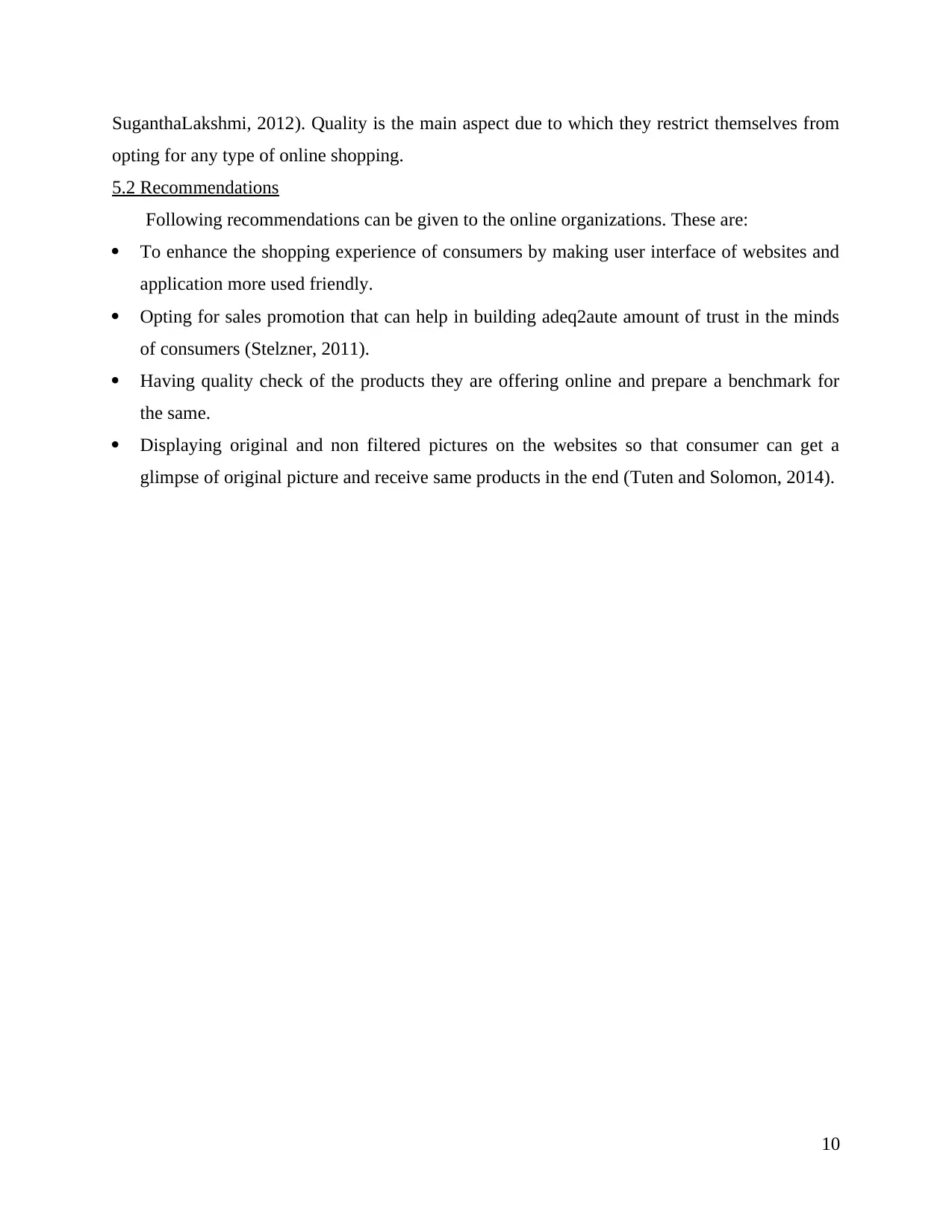
SuganthaLakshmi, 2012). Quality is the main aspect due to which they restrict themselves from
opting for any type of online shopping.
5.2 Recommendations
Following recommendations can be given to the online organizations. These are:
To enhance the shopping experience of consumers by making user interface of websites and
application more used friendly.
Opting for sales promotion that can help in building adeq2aute amount of trust in the minds
of consumers (Stelzner, 2011).
Having quality check of the products they are offering online and prepare a benchmark for
the same.
Displaying original and non filtered pictures on the websites so that consumer can get a
glimpse of original picture and receive same products in the end (Tuten and Solomon, 2014).
10
opting for any type of online shopping.
5.2 Recommendations
Following recommendations can be given to the online organizations. These are:
To enhance the shopping experience of consumers by making user interface of websites and
application more used friendly.
Opting for sales promotion that can help in building adeq2aute amount of trust in the minds
of consumers (Stelzner, 2011).
Having quality check of the products they are offering online and prepare a benchmark for
the same.
Displaying original and non filtered pictures on the websites so that consumer can get a
glimpse of original picture and receive same products in the end (Tuten and Solomon, 2014).
10
⊘ This is a preview!⊘
Do you want full access?
Subscribe today to unlock all pages.

Trusted by 1+ million students worldwide
1 out of 15
Related Documents
Your All-in-One AI-Powered Toolkit for Academic Success.
+13062052269
info@desklib.com
Available 24*7 on WhatsApp / Email
![[object Object]](/_next/static/media/star-bottom.7253800d.svg)
Unlock your academic potential
Copyright © 2020–2025 A2Z Services. All Rights Reserved. Developed and managed by ZUCOL.





